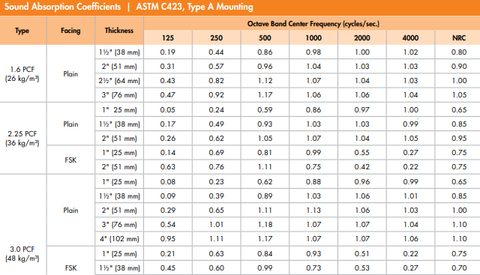Insulating for Acoustics (Sound Proofing and Sound Absorption)
I find that soundproofing and sound absorption often get confused when deciding how to insulate your system. Soundproofing is the most critical component when you are trying to block sound from transferring from one room/location to another room/location. Sound absorption is the most critical component when you are concerned with echo and sound bouncing off walls within a room.
Sound Absorption is fairly easy to control. Most batt insulation and board insulation products have published sound absorption coefficient (NRC) on their data sheet.

The higher the Sound Absorption Coefficient the better for the acoustics within your room.
Soundproofing gets more complicated on the correct solution for your problem. If we look at it in terms of extremes, let’s consider a concrete wall compared to a wall composed of only light density fiberglass batt (no drywall at all). If you are in the adjacent room behind the concrete wall you are going to hear your neighbor’s conversations much less than if there was only fiberglass batt between you and your neighbor. In this example, concrete is superior soundproofing material than only fiberglass batt insulation. If you were inside the room having the conversation, however, you are going to hear a lot less echo if your wall is fiberglass batt compared to the concrete wall. In this example, fiberglass batt is a much better sound absorber than a concrete wall.
Of course, a good wall system should have both sound absorbing components and sound proofing components. As a result, if I were looking to add some sound proofing to a wall or a noisy duct system, I would consider using a denser board insulation product rather than a batt insulation product. I would use a Fiberglass board insulation such as this one or an even denser Mineral wool board insulation. These two products will add more soundproofing to your system than a light-density batt insulation.
If we are looking at noisy ceiling from neighbors above, for example, you may have a different problem all together that no amount of high density fiberglass board or mineral wool board insulation will alleviate. Your sound could be coming from vibration. If the drywall on your ceiling is installed against the same joists as your neighbors floor that vibration will run through the joist and into your room. You will need to separate the drywall from the joist.
If you are dealing with soundproofing against vibration from a noisy pipe and/or duct the recommended product to use is a B10 lag material. This sound proofing pipe lagging material is available with or without a fiberglass blanket sound absorber.
These sound absorbing lagging products are non-stock items for us so please feel free to send us an email and we will gladly obtain you a quote.

